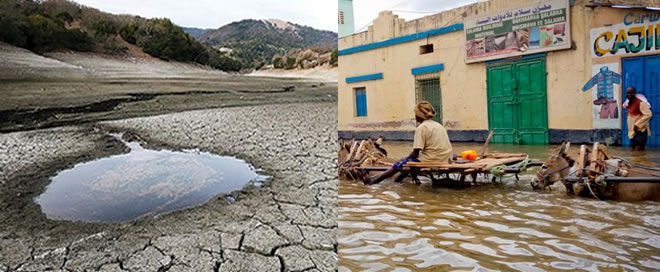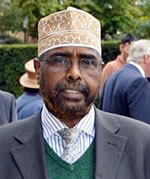
From dry to flooding, This is image of Shabelle River
 |
Mohamud Haji Elmi
Saturday, July 09, 2016
Walking on the Shebelle River on 22nd of March was something unusual to many Somalis; this was an event which has not occurred in living memory. It has become strong testament that we have indeed entered a new geological age; the Anthropocene. The term Anthropocene was first used in 1873 by the late Italian geologist Antonio Stopanni when he described the affect humans were having on the earth’s systems as Antrhopozoic’.
The term is now widely used to describe our current geological time period that began when human activities started to have a significant global impact on the Earth's geology and ecosystems. It is climate change and it is only now starting to be felt painfully in the horn of Africa. The pattern of rain and drought for the last 80 years is not well documented in Somalia as well as many parts of Africa. But surely the people in this particular region have witnessed several droughts some of them even have names such as dabadheer (the long tailed) which happened in 1974.
The current floods which displaced most of the residents of Beletweyn are not something new to happen; these people have seen such a similar situation. They become victims of droughts and floods. Receiving an annual rainfall within 14 days with great intensity is something common in Somalia; in some incidents the country receives 20% of its annual rainfall within 18 hours. This is damaging to the land and washes away the top fertile soil. In such conditions we must use unique solutions to tackle these issues. When the land is not covered with trees, the water retention capacity will be reduced; hence runoff from the hill sides passes within hours. A great volume of water is lost in that way which otherwise could have replenished the groundwater. That water has a few days of residence time on the necked land and most of the time cause floods and soil erosion.
The failure of two consecutive rain season, including the summer rain that normally feeds 80-85 per cent of the country population, but was exceptionally weak this year, has devastated livestock and greatly increased malnutrition rates in six Ethiopian regions. Low rainfall and long spell droughts affect Shebelle river flow, but many Somali people believe that Ethiopia’s small sized construction dams in the upper stream is the main factor which reduced the flow of the river towards its original path .In fact the situation seems a bit different than they perceive. Historically the Shebelle River performed like today 100 years ago and there were no dam in upper stream, but the reality was a prolonged drought which significantly lowered the water table level, hence threatening the base flow of the river which used to be nourished by groundwater.
Another factor is deforestation around the watershed of the river. Deforestation causes droughts as well as floods. Trees are called heart of moisture cycle. Careless destruction of forest in the Deep South and Southwest is the chief causes of the droughts in the Middle West according to Fredrick Cowles, forestry expert and Oregon rancher.“Trees” Cowles said “are to the earth what the heart is to human body
To understand it, note that in the arid Central Valley of Shebelle River, farmers and nomads are directly or indirectly dependent on rain with the exception of some permanent wells used mainly for watering livestock.
When drought hits unprepared community it has a wider meaning unexplained for a couple of decades. Drought means lack of soil moisture to support vegetation necessary for animals and people, hence practicing groundwater utilisation to irrigate small farms as a safeguard could become a lifeline. Keeping the water in the soil and allowing percolating is some something not fully understood among many nomads. Surface water reliance can no longer be trusted if Somali’s want to be well prepared to survive from a distant drought on the horizon.
Every river has a point of origin, for Somalia the Jubba and Shabelle rivers begin their journey in the Ethiopian highlands. Since gravity plays a vital role, Somalia is blessed to have these two rivers as they almost always follow a downhill slope. Thus the point of origin for rivers tends to be the highest point in the watercourse. Somalia is a discharge ground of the precipitation occurring in the Ethiopian highlands. In the event of heavy rainfall no one can stop that huge volume of water on their way downstream, unless a huge dam is built that can hold billions of cubic metres. In the Anthropocene, humanity is draining the world’s rivers and other sources of fresh surface water. Climate change has altered the global water cycle from its Holocene norms to intensifying evaporation and precipitation. There is greater flooding, worsening droughts and general loss of predictability that makes planning more difficult for people trying to adapt. If you see a dried river bed due to a prolonged drought, it is because that river has lost the base flow of groundwater.
Two third of watershed of river Shebelle originates from Ethiopian highlands, but this year the country faced its worst drought in decades, with more than eight million people already in need of food assistance as a result of weather conditions that are set to worsen
Another factor is deforestation around the watershed of the river. Deforestation causes drought; Trees are called heart of moisture cycle. Careless destruction of forest in the Deep South and Southwest is the chief causes of the droughts in the Middle West according to Fredrick Cowles, forestry expert and Oregon rancher.“Trees” Cowles said “are to the earth what the heart is to human body
If we take care of the steps to moisturise the land and grow the trees, nature takes it to the next step of forming clouds. Initially thin cloud will be formed. These clouds help us to reduce the temperature in that area by blocking sun light. Once the clouds thicken, it will not have any other choice but rain. Till it rains, we need to keep the land wet and trees alive. If we keep the land wet, growing trees is not a problem. Now the only problem is how to keep the land wet for so long time. If we solve this problem, then the bog problem of drought is solved.
It is clear that both rivers Juba and Shebelle are the life line of many Somali farmers inhabiting the most fertile arable land in Hiiraan, Lower Shebelle, Middle Shebelle as well as lower Juba, in fact it is considered the bread basket of the whole nation. It is important to respect the environment to achieve a wining solution for both upper stream and downstream inhabitants
Mohamud Haji Elmi
Co-founder & Executive Director of Drought Control Somalia
London UK
[email protected]
www.droughtcontrol.com